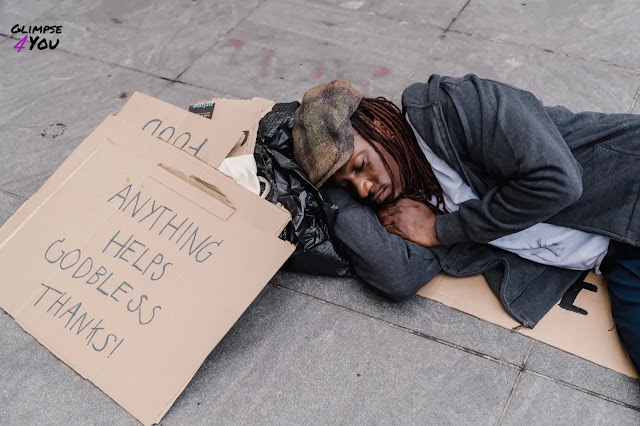The concept of homelessness
Homelessness can be defined from a linguistic perspective as the individual's lack of a home or a job, which is the question of people to meet the requirements of life, while the US Department of Housing and Urban Development defined it as the individual's suffering that is manifested in the following:
- The individual does not have a shelter suitable for human habitation or has resided in places not designated for housing, such as shelters, for at least one year.
- The individual's stay in a community institution; such as hospitals to receive treatment for mental disorders, or in prison, for no less than ninety days, given that the conditions of the first point apply to him.
- Disruption of the family system as a result of the absence of ahead of the family to manage its affairs, or as a result of his incapacity; This leads them to the demonstrations mentioned in the first point.
The term homelessness may apply to and affect many groups in society, including the elderly, children, and youth, and a person may become homeless for several reasons; Including job loss and lack of income, suffering from health or mental problems, exposure to domestic violence, or a disaster in the home; Such as fires, floods, or wars
Causes of homelessness
Poverty
The unemployment
The individual may be unable to achieve the basic requirements of life, including housing, due to the absence of a source of income for him from a stable job, or due to the sudden loss of the job that was a source of his safety and fulfillment of his needs, amid a functional society where it has become difficult for the individual to find a job opportunity easily.
It may lead to the eviction of the individual from his home and homelessness.
Domestic violence
One of the reasons for homelessness is domestic violence, since a person may be compelled to choose between staying in a house where he is exposed to one or leaving. of the types of abuse represented by physical, sexual, or psychological abuse, or leaving without a suitable shelter for him, as Canadian statistics estimated that 237 people were subjected to Out of every 100,000 people who are abused, they may choose a life of homelessness in exchange for staying in a home where they are exposed to abuse and abuse, and some relevant statistics indicate that 90% of women who end up as homeless came as a result of the abuse they were exposed to. during their lives.
Mental disorders
Diseases and physical disabilities
Addictive disorders
Jail
Harsh personal circumstances
Suggested solutions to the condition
At the individual level
- Understanding the development of condition helps to dispel the stereotype taken concerning the homeless, and knowing the circumstances that semiconductor diode them to the present state of affairs, to produce the individual with the talent of coping with every case of condition fitly - because of its privacy - and attempting to seek out solutions to that, the primary steps taken in finding the issues of the homeless you start to know their desires, study every case singly, and find nearer to them as a result of they have somebody to speak to, feel their feelings and create them feel cared.
- Creating an applied math methodology for exile shelters, distinguishing their locations to form it easier for displaced folks to travel to them.
- Delivering direct financial facilitation to the homeless or providing relief and donations to them through recognized charitable organizations.
- present surplus garments, only if they're respectable and in good shape, through charities liable for distributing aid to the homeless.
- Donating toys and books, presenting gifts to homeless youngsters, or providing necessary food things, additionally to urging friends and acquaintances to require such action.
- Working within the volunteer sector to help the homeless, wherever every individual could contribute services acceptable together with his or her abilities, instructional credentials, and interests.
- Volunteering in teaching the homeless among the colleges selected for them, if any, or among their shelters, or acting on this singularly.
- Through the event of awareness reports and their dissemination through completely different ways of business, like newspapers, homes of worship, and others, increasing social awareness of the issues of the homeless and therefore the active role performed by charities to assist them.
At the international level
- Adopting effective policies and strategies to eliminate the phenomenon of homelessness, with continuous care and emphasis on the relevant authorities in this regard within the country to implement those strategies within specific time frames.
- enact laws that guarantee the protection of the homeless from the violations that they may be exposed to by others; such as defamation, discrimination, and ill-treatment.
- Repealing the law of people evacuating their homes when they are unable to pay the rent, which will result in an increase in homelessness, and finding a better alternative to the laws of immediate eviction, such as securing alternative housing, or finding productive lands for the benefit of those affected.
- Obligating states not to legislate any law or policy that may motivate the creation of any situation of homelessness, considering this as a clear violation of human rights.
- Legislation of policies by the state to ensure synergy between the public and private sectors - specialized in the residential fields - and to set conditions that would provide housing buildings at affordable prices that suit everyone
- Preparing plans and strategies to create new job opportunities to eliminate unemployment and raise the level of per capita income.
- Homelessness forms of homelessness of several types, the most beautiful of which is the Australian Center for Statistics in three types, as follows:
- Primary homelessness: Primary homelessness refers to people who are forced to sleep in streets, parks, public facilities, or even cars; Temporarily as a result of their lack of shelter like the rest of the individuals.
- Secondary homelessness: People who move from one shelter to another, such as refugees and residents of emergency shelters or move between the homes of family and friends and reside in places temporarily suffer from what is called secondary homelessness.
- Category III homelessness: It is indicated that individuals who live in homes that do not contain the basic necessities of life; such as bathrooms, kitchens, suffer from Tertiary homelessness, as well as those who do not have a long-term lease.



Comments
Post a Comment